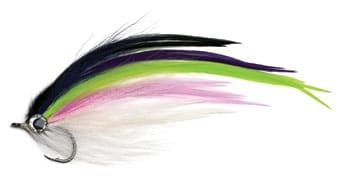
The Most Important Fish in the Sea – that is the title H. Bruce Franklin chose for his groundbreaking book on menhaden. It is aptly named considering the economic and ecological significance of this keystone species – not to mention the menhaden’s importance to saltwater fly tiers!
These baitfish are known scientifically as Brevoortia tyrannus. Most fishermen along the East Coast, however, simply refer to them as bunker. Menhaden play a vital role in a healthy ecosystem. They are filter feeders, feeding on tiny phytoplankton and zooplankton. Without primary consumers like bunker, the energy stored in phytoplankton would be lost, never to be passed on to higher species in the food web, such as the prized game fish we fly-fishermen seek.
By vacuuming up literally tons of pelagic phytoplankton from the water column, bunker help keep estuary waters clear. Without good water clarity, underwater grasses cannot receive the necessary sunlight to survive. These underwater fields provide critical nursery habitat to fish and crustaceans. Indeed, the total ecological significance of the lowly bunker has yet to be fully realized.
Unfortunately, populations of menhaden have been depleted by commercial interests. This is especially true in my home waters of Virginia, where a single company holds a monopoly on what is basically an unregulated fishery. Spotter planes and purse seines wipe out entire schools holding thousands of fish.
Yet despite poor management of the species, bunker remain the primary food source for game fish up and down the Atlantic seaboard. Adult striped bass in particular find the oily, high-protein composition of bunker to be the crème de la crème. Studies have shown that, historically, menhaden have represented 80 percent of the diet of stripers in Chesapeake Bay.
A Challenging Body Shape
Take a good look at a menhaden and you will notice they have a unique body build. Bunker have an unusually high profile when viewed from the side but are narrow in width when viewed from below. The species uses this body design to its advantage in open water, where they spend the majority of their lives. With no structure to hide from predators, menhaden use their tall bodies as rudders to make quick changes in direction to avoid speedier game fish.
The dilemma we are faced with as fly tiers is replicating the shape of menhaden with a lifelike fly. Two- to 6-inch juvenile bunker patterns can be readily constructed using techniques such as the “high-tie” method of building multiple layers of material along the hook shank, from the bend of the hook to the eye of the hook.
The true challenge comes when tying larger, 6- to 12-inch menhaden fly patterns. Most large bunker flies end up bulky and difficult to cast. While many menhaden patterns have a high profile sitting on the tying table, they collapse when wet. The imagery of chucking a wet sock comes to mind for many fly anglers.
From Baby Bottles to the Birth of a Bunker Fly
Amid the cries of my infant baby girl, Evelyn Anne, the idea came to me one night of a method to build a large but sparsely tied, high-profile fly through the use of wired portions of hair and feathers.
So off to my tying bench I lumbered during one of Evie’s short naps. (Whoever coined the phrase “sleeping like a baby” never met my daughter!) I rummaged through boxes of materials, gathering bucktail, long saddle patches and single- strand wire. I lashed a small clump of bucktail and a few thin saddle hackles to a short piece of wire. Then I repeated the process, creating several separate pieces. My goal was to bend the wired portions to the desired angle before attaching the wire to the hook shank. This technique allowed me to prop up the materials at much higher angles than could be achieved from traditional tying methods of securing the materials directly to the hook shank.
The use of wire allowed for construction of a fly with far less material as well. The wire provided support, so excess material could be eliminated. The result was a high-profile fly that had little air resistance when cast and lively action when stripped through the water. The Wired Bunker fly was born.
The Perfect Testing Ground
It was early January at the Chesapeake Bay Bridge-Tunnel, and there is no better place for wintertime striper fishing (see “Double Your Pleasure” in the January/February 2009 issue of FFSW). My client and I were greeted in short order by acres of diving gulls picking off fleeing menhaden.
The bunker were being driven to the surface by striped bass from below. I rigged a rod with the freshly tied Wired Bunker from the night before, and my angler quickly aerialized the fly. By the time I closed my fly box, I heard the shout of “fish on!” The hooked bass eventually came boatside for release, and the next thing I knew, the process was repeated again and again. This happened 20 times, as striper after striper chomped on the bunker pattern. Things were going good indeed!
My angler that day made one more cast and retrieve before his line came tight again – only this time line started screaming off his fly reel. After a lengthy battle, a large bass slid into my net, and I hoisted her aboard. The fish taped out at 41 inches, a trophy by anyone’s standards! After a round of hoots, hollers and high-fives, my client declared, “Captain, you better tie me a dozen of these flies when you get home!”
Hopefully, a few of these flies will find their way into your vise and fly box too.
Next page: Tying Instructions
Materials
Hook: Tiemco 600SP, 2/0 to 6/0
Thread: Danville Flat Waxed Nylon, 210 Denier
Wire: Malin Hard Wire, size 10
Body: Long bucktail
Wing: Long, narrow saddle hackle
Eyes: 3-D prismatic, 3/8″ to 3/4″
Glue: Beacon 527
| Step 1: Cut a 1/2-inch piece of wire and place it in your vise. Secure thread near the end of the wire. Tie in four saddle hackles surrounded by a small clump of bucktail. Repeat this process on new pieces of wire, varying color as you please, until you have a total of four complete pieces. |
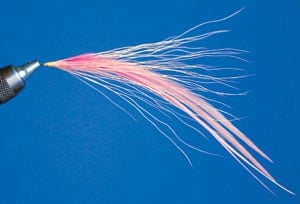
| | Step 2: Repeat Step 1, but tie in only a small clump of bucktail with no hackle. Continue until you have three complete pieces.|
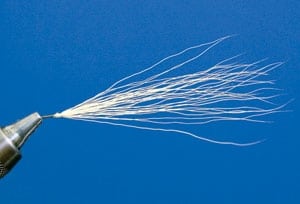
| | Step 3: Place hook in the vise, and tie in a medium clump of bucktail in front of the hook bend, followed by four saddle hackles tied in flat.|
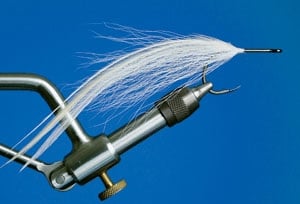
| | Step 4: Tie in the wired pieces. You will work your way from the rear of the hook to the eye of the hook, placing each new piece in front of the last. The pieces with hackle and bucktail are tied on top of the hook shank. The pieces with only bucktail are tied on the bottom. Before tying in each wired portion, bend it with a pair of pliers to the angle you would like the material to be elevated off the hook shank.|
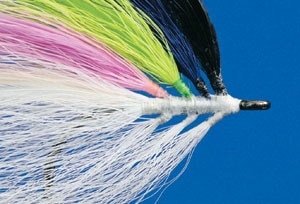
| | Step 5: Apply glue along the tie-ins for durability, and attach dome eyes.|
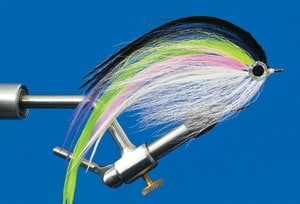
|









